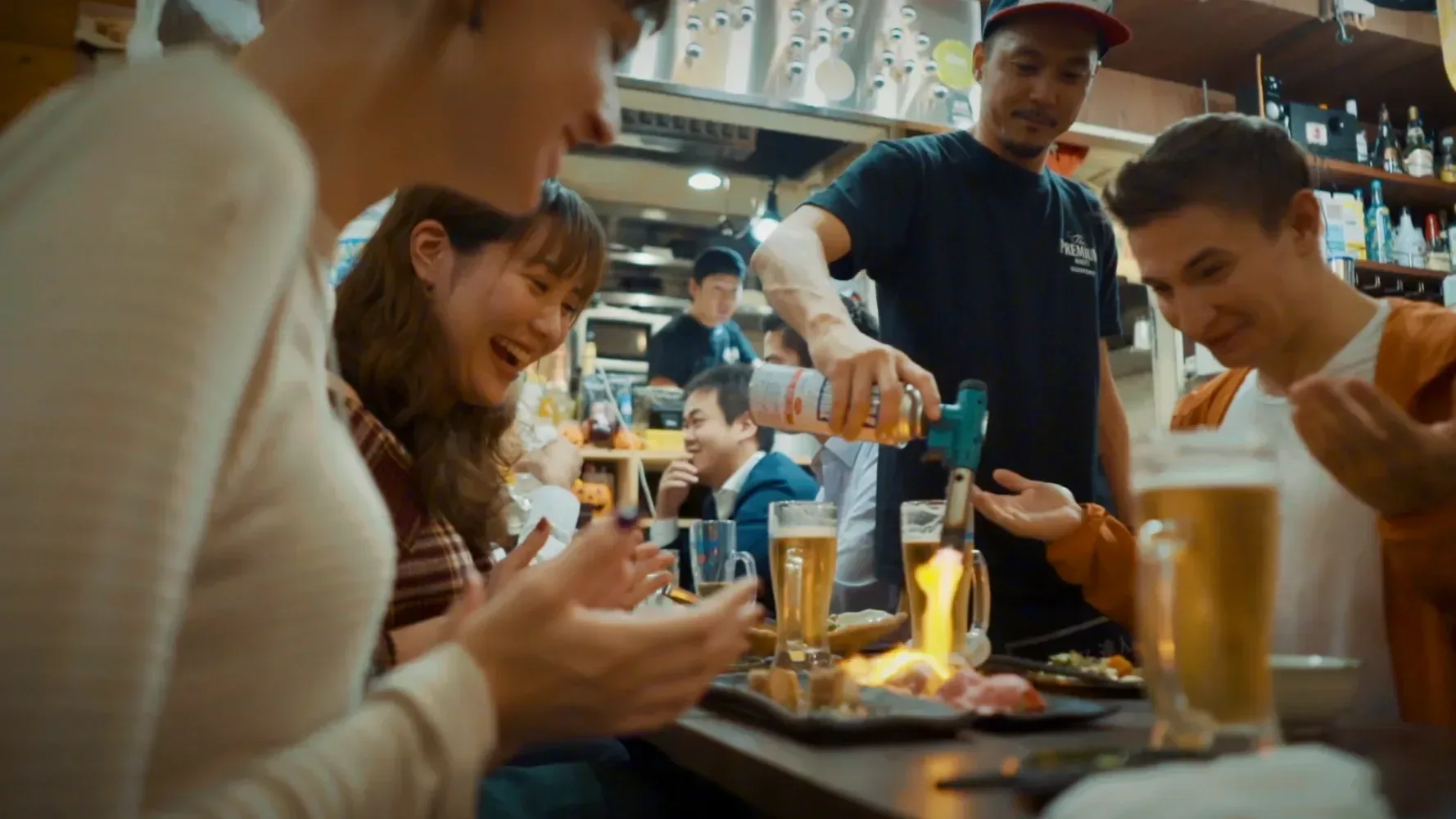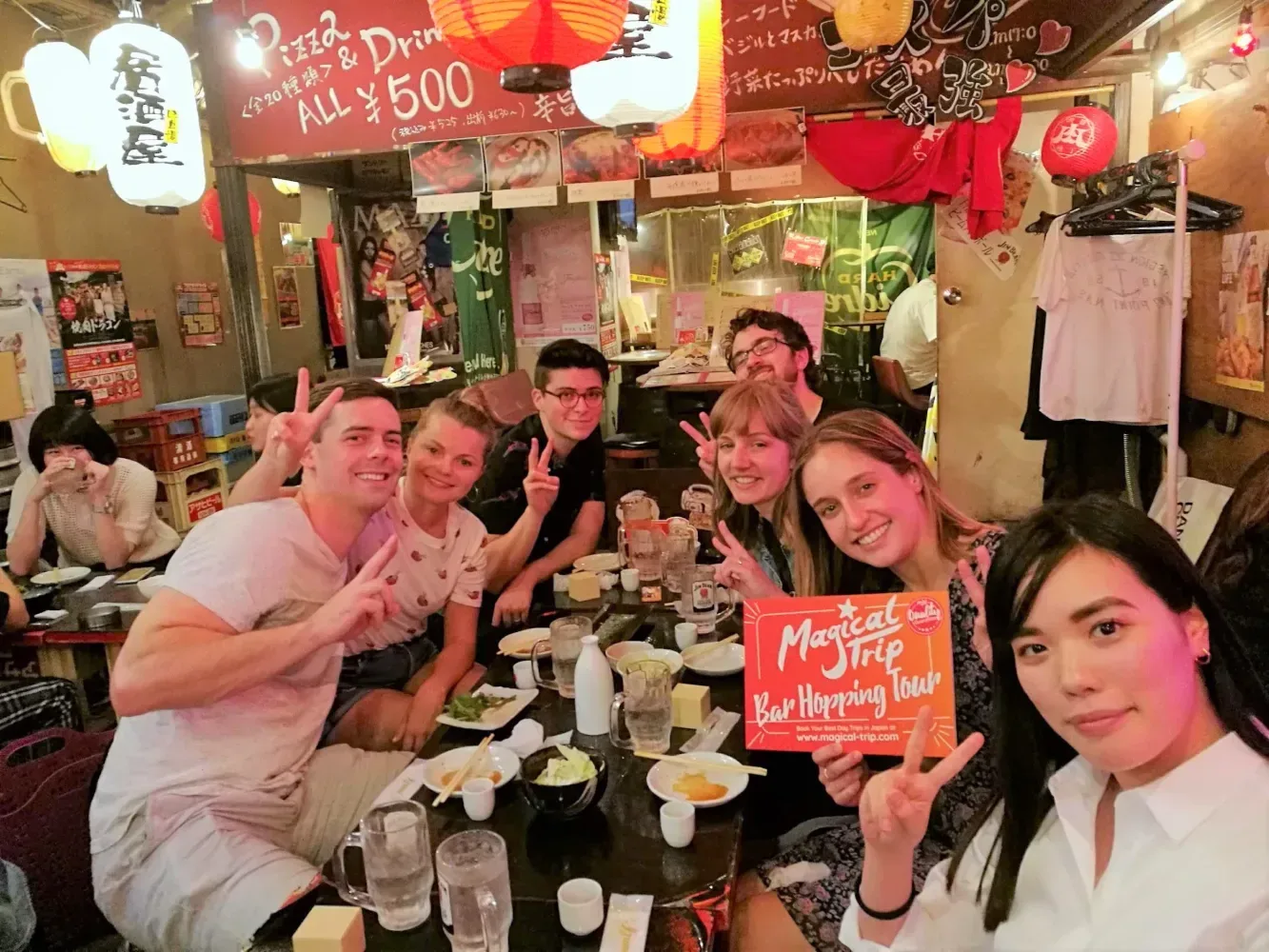Shibuya: Recommended Temples and Shrines List
Since its publication in July, this article has served as a guide for international tourists exploring Shibuya. I'm updating it now because I moved to Shibuya in October 2024 and want to include my discoveries of new street food spots and the latest hotspots for 2025.
Another reason is the growing interest in tours with locals who knows Tokyo very much.
Magical Trip also offers numerous tours where you can explore the city and enjoy bar hopping with local guides who know Tokyo inside and out. Due to its popularity and high quality, their "Tokyo Bar Hopping Night Tour in Shinjuku" was ranked #1 among all tours on TripAdvisor in 2024.

The top-ranked tour is the Tokyo Bar Hopping Tour held in Shinjuku, but the Shibuya Bar Hopping Night Tour held in my hometown, Shibuya, is equally attractive. By highlighting the fun of Shibuya nights, I hope more people will join the Shibuya Bar Hopping Night Tour.
Once you've set up your day's itinerary in this article, plan more of Shibuya's quintessential nightlife below.
Make the most of your night out in Shibuya with one of Magical Trip's top-rated articles below in hand.

Introduction
Shibuya, known for having the "world's busiest intersection" with its famous Scramble Crossing, is a popular destination for many people. It's also a hub for Japanese youth culture, including fashion and subculture, and has recently gained popularity as a setting for anime. I can say that Shibuya is one of the most popular neighborhoods in Tokyo.
Shibuya also has a unique aspect as an art and music district, with distinctive museums, live music venues, and clubs. Popular among both Japanese and foreign visitors, it's known as a city that never sleeps, with many restaurants open late into the night.
Additionally, it's undergoing a major redevelopment said to occur once in a century, making it a constantly changing city. I sometimes visit Shibuya, and I am always surprised because every time something has changed.
While Shibuya is evolving, there are still something that remain unchanged, such as the Hachiko statue, which recently celebrated its 100th anniversary. I, who love to visit shrines and temples will introduce them in Shibuya.
What's the difference between temples and shrines?
The representative religious facilities in Japan are temples and shrines. While they may seem similar as places to pray for peace, there are differences. Here's an overview of their characteristics:
Temples are associated with Buddhism. They are places to study and practice Buddhist teachings, founded by Buddha. They worship Buddha, and many have a principal object of worship that can be viewed as a statue. Many temples also conduct funerals and manage cemeteries.
On the other hand, shrines are associated with Shinto. Shinto is Japan's indigenous religion, based on the belief that gods dwell in all existences including nature, people, objects, and land. Shrines are where gods reside, but the enshrined deities cannot be seen from outside. Besides the priest who performs prayers, there may also be shrine maidens who assist.
Many Japanese visit both temples and shrines, typically going to temples for funerals and shrines for New Year's visits.
Rules for worshipping
There are also differences rules when visiting temples and shrines. At temples, after offering money, you put your hands together in front of your chest in prayer. You don't clap.
At shrines, the basic ritual is "two bows, two claps, one bow" (Bow twice, clap your hands twice, and then put your hands together and pray and bow again before you leave.), followed by putting your hands together in prayer.
As common etiquette for both temples and shrines, it's recommended to keep the following points in mind:
・Bow slightly when entering the premises. (At the main gate for temples, at the Torii gate for shrines)
・Wash your hands before praying. (This symbolizes purifying your heart and body)
・When leaving the premises, bow slightly again as a gesture of respect.
By the way, at temples, it's considered disrespectful to step on the threshold of the gate, and at shrines, to walk in the middle of the path, so be careful.
Recommended Shrines
Meiji Jingu Shrine
Meiji Jingu Shrine is the largest shrine in Shibuya. It enshrines Emperor Meiji, who reigned over 100 years ago, and his consort. Most of the vast grounds are covered in forest, making it a refreshing place to visit when tired of the city air.
As it's a place that prays for peace in Japan and the world, you might feel a sense of tranquility. It's recommended to visit early in the morning when there are relatively few people. It takes about 30 minutes round trip to walk to the main shrine, so please wear comfortable clothing.
Although there's an entrance fee, the Jingu Garden, centered around a pond made from one of Tokyo's leading spring water sources, is also recommended for a stroll.
<Information>
・Address: 1-1 Yoyogikamizonocho, Shibuya-ku, Tokyo
・Phone: 03-3379-5511
・Opening hours: Opens at sunrise, closes at sunset (times vary by season)
・Access: JR Harajuku Station, Meiji-jingumae Subway Station
・Official website: https://www.meijijingu.or.jp/
Konno Hachimangu Shrine
Source: Official website
If you want to visit a shrine near Shibuya Station, Konno Hachimangu is recommended. Despite being just a 5-minute walk from the station, it offers a quiet and calm atmosphere.
Konno Hachimangu is a shrine built about 1000 years ago, enshrining a former emperor as its deity. The red color of the main shrine, an important cultural property of the area, uses Japanese lacquer. Lacquer is sap obtained from plants native to Japan and is applied using traditional Japanese crafting techniques.
Cherry trees are planted in the grounds, said to originate from the Konno cherry tree planted by Minamoto Yoritomo, a shogun from the Kamakura period about 800 years ago.
Cute-shaped fortune slips are also sold, so be sure to check out the amulet office as well.
<Information>
・Address: 3-5-12 Shibuya, Shibuya-ku, Tokyo
・Phone: 03-3407-1811
・Opening hours: -
・Access: 5-minute walk from Shibuya Station
・Official website: https://www.konno-hachimangu.jp/
Hikawa Shrine
Source: Official Facebook
Hikawa Shrine is said to be the oldest shrine in Shibuya. According to a book recording the shrine's origins written in 1605, its origins date back to 110 AD, before Japan took shape as a country.
The emperor at that time, wanting to extend his influence to the eastern regions, ordered his son, Prince Yamato Takeru, to conquer the East. The place where he prayed for the gods' power during the invasion of his army is the origin of Hikawa Shrine.
Yamato Takeru is very popular in Japanese mythology as a tragic prince who was feared by his father, the emperor, for being too strong, and was continuously ordered on expeditions, ultimately unable to return home.
The shrine accepts prayers for good relationships on the 15th of every month, so if you're interested, please visit.
<Information>
・Address: 2-5-6 Higashi, Shibuya-ku, Tokyo
・Phone: 03-3407-1811
・Opening hours: -
・Access: 18-minute walk from Shibuya Station
・Official Instagram: https://www.instagram.com/shibuyahikawa/
・Official Facebook: https://www.facebook.com/shibuyahikawa/?locale=ja_JP
After enjoying shrines and temples during the day, it's recommended to experience bar hopping at night with a local guide who knows Tokyo inside and out.
If you have a guide who thoroughly knows Shibuya showing you around, you can enjoy Shibuya all day long.
・Shibuya Bar Hopping Night Tour in Tokyo

Yoyogi Hachimangu Shrine
Source: Official website
Yoyogi Hachimangu is a shrine founded by a samurai in 1212.
The enshrined deity is a former emperor, also called Hachiman. Hachiman is a god often revered by samurai, believed to protect the country and ward off evil.
Yoyogi Hachimangu is still popular as a shrine for warding off bad luck and bringing good fortune.
You can refresh yourself by experiencing nature in the natural forest remaining on the grounds. Remains of a dwelling from the Jomon period, about 5000 years ago, have also been discovered, and a reconstructed dwelling is displayed outdoors.
Annual events are also vibrant, including bean-throwing and mochi-pounding, and children's New Year's calligraphy is sometimes displayed. You might get a glimpse of local life while visiting the shrine.
<Information>
・Address: 5-1-1 Yoyogi, Shibuya-ku, Tokyo
・Phone: 03-3466-2012
・Opening hours: -
・Access: 5-minute walk from Yoyogi-Hachiman Station or Yoyogi-Koen Station
・Official website: https://www.yoyogihachimangu.or.jp/
Recommended Temples
Korinin Temple
Source: Official Facebook
Korinin is a temple in Hiroo, Shibuya Ward. It's about a 5-minute walk from the station, but as there are many temples in the area, it's best to check a photo of the gate beforehand to avoid getting lost.
Passing through the distinctive semicircular main gate, you can see the tranquil temple grounds. The highlight of this temple is the tea room, designated as an important cultural asset of Shibuya. Although it may not always be open to the public, you can still feel its dignity just by looking at the exterior.
The temple is also famous for holding Zen meditation sessions at 7 am on weekdays and 5 pm on Sundays. It's not a class that teaches meditation from scratch, so beginners might be confused, but there are foreign participants, so if you're interested, why not give it a try?
<Information>
・Address: 5-1-21 Hiroo, Shibuya-ku, Tokyo
・Phone: -
・Opening hours: -
・Access: 5-minute walk from Hiroo Station
・Official Facebook: https://www.facebook.com/kourinin?locale=ja_JP
Shouunji Temple
Source: Official website
Shouunji is a temple in Hiroo, Shibuya Ward, like the previously mentioned Korinin. It's one of the largest temples in Shibuya, and the Hiroo shopping street has developed around this temple.
You can feel the Zen temple's aesthetic, which finds beauty in simplicity and imperfection, throughout the temple. There's also a tea room near the Japanese garden at the back. It's a place where you can feel the beauty of the four seasons.
Shouunji also holds Zen meditation sessions. For a fee and with a reservation, you can participate and learn how to do Zen meditation. Events like copying sutras (using Japanese calligraphy to copy Buddhist sutra text) are also held, so if you're interested, it's worth inquiring about.
<Information>
・Address: 5-1-21 Hiroo, Shibuya-ku, Tokyo
・Phone: 03-3400-6526
・Opening hours: -
・Access: 5-minute walk from Hiroo Station
・Official website: https://shouunji.or.jp/temple
Chousenji Temple
Source: Official website
Chousenji is a temple located between Harajuku and Shibuya. It's a historic temple that can trace its origins back to 1063. Although it has experienced ups and downs, including fires and near abandonment, it has been rebuilt each time.
The principal object of worship is Buddha, believed to save and guide people who are troubled and suffering.
There's an interesting anecdote about the Goddess of Mercy enshrined in the Kannondo Hall. It's said that she helped a devout samurai in battle. At that time, the statue of the Goddess of Mercy was wet like sweaty human skin, hence it came to be called the "Human Skin" Goddess of Mercy.
It's a temple where you can feel tranquility even in the middle of the city, so please drop by if you're in the area.
<Information>
・Address: 6-25-12 Jingumae, Shibuya-ku, Tokyo
・Phone: 03-3407-6783
・Opening hours: -
・Access: 7-minute walk from Harajuku Station
・Official website: https://chousenzenji.com/about/index.html
Discover Tokyo's Best Hidden Dining Spots
Ready to experience Tokyo's famed nightlife through a local lens? Join these intimate bar hopping tours for an unforgettable journey through the city's most exciting neighborhoods, where expert guides reveal the secret spots that tourists rarely find.
Shibuya Bar Hopping Night Tour in Tokyo

Delve into Shibuya's lesser-known culinary world during this enriching three-hour experience ($106.51). Moving beyond the iconic crossing and bustling streets, you'll discover authentic dining spots in areas like the charming Niku Yokocho, where locals gather for some of Tokyo's finest meat dishes.
Your evening features stops at three distinct venues, each specializing in premium Japanese beef. Sample exquisite wagyu, savor the renowned Kobe beef, and try innovative beef sushi creations. The tour includes four drinks and multiple dishes, promising a satisfying dinner experience.
Led by knowledgeable English-speaking guides in small groups, you'll gain insights into Japanese dining etiquette and local culture. Suitable for guests 15+ (alcohol served to 20+ only), with options available for various dietary needs.
Start your culinary adventure at TSUTAYA near the famous Hachiko statue, where your guide will lead you into Shibuya's hidden food paradise.
Details here: Shibuya Bar Hopping Night Tour in Tokyo
Tokyo Bar Hopping Night Tour in Shinjuku

Step into Shinjuku's maze-like streets for this acclaimed 3.5-hour tour ($105.56). Named TripAdvisor's #1 Japan experience in 2024, this beloved tour has already shown over 20,000 guests the authentic side of Tokyo's largest entertainment district.
Visit three carefully selected izakayas serving Japanese classics like succulent yakitori, freshly prepared gyoza, and perfectly fried tofu. Four included drinks complement your food journey, offering a true taste of local dining culture.
Your expert guide navigates both the nostalgic lanes of Omoide Yokocho and the vibrant streets of Kabukicho, sharing fascinating insights throughout. Welcoming guests aged 15+ (alcohol for 20+ only), the tour caters to various preferences, including vegetarian options.
Meet at the black pillar beside UNIQLO's Shinjuku West Exit Store, where your evening of discovery begins.
Details here: Tokyo Bar Hopping Night Tour in Shinjuku
Both tours include professional photography and offer flexible 24-hour cancellation policies. Whether you're exploring solo or with friends, these intimate guided experiences provide the perfect introduction to Tokyo's legendary food culture, ensuring memories that will last long after your journey ends.
Shibuya is a district where cutting-edge shops, culture, and people gather, but it also has historic shrines and temples throughout. Most temples and shrines are basically open for anyone to visit freely.
If you're tired of the hustle and bustle of the city, it might be good to stop by a shrine or temple. Some places, like Meiji Jingu Shrine, have large grounds with rich nature. You can refresh yourself surrounded by trees.
There are also temples in Shibuya that hold meditation sessions and events. Not only Japanese but also foreigners participate in these, so if you're interested, why not first inquire if they can accommodate English speakers?











